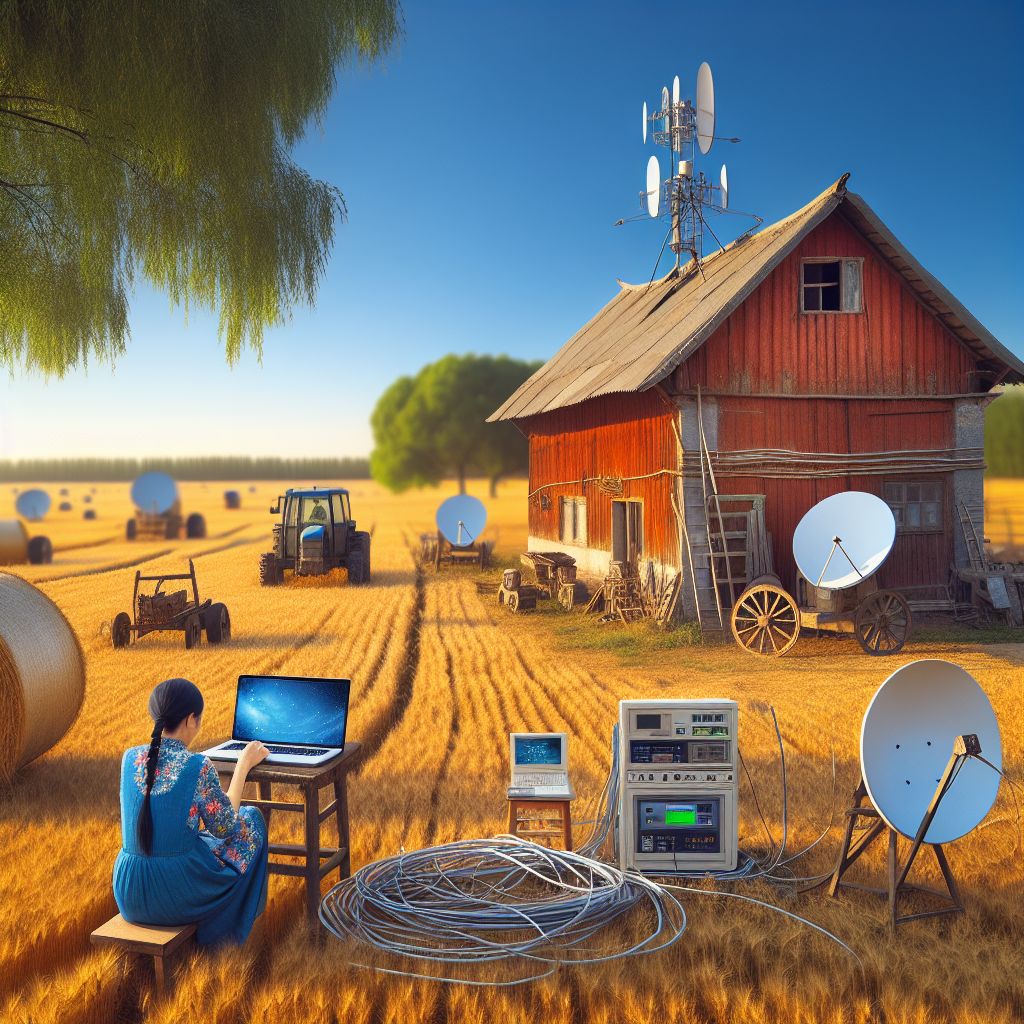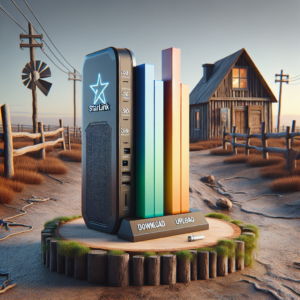Key Takeaways
Starlink offers higher speeds and lower latency compared to HughesNet, making it a game-changer for rural and remote farming operations.
Access to fast and reliable internet through Starlink can significantly enhance farm productivity by enabling precision agriculture and efficient data management.
Despite its advantages, Starlink’s initial setup costs and equipment can be higher, but the long-term benefits for farm efficiency can justify the investment.
HughesNet provides wider availability and has been a reliable service for basic internet needs, but may not support the bandwidth-intensive requirements of modern farming tools.
Understanding the specific needs of your farming operation is crucial when choosing between Starlink and HughesNet for your rural internet service.
Digging Deeper: How Starlink Enhances Farm Productivity
Let’s get into the nitty-gritty of how a faster internet can transform the way we farm. Imagine a world where every drop of water is accounted for, where every seed’s growth is monitored, and where every animal’s health is tracked in real-time. This isn’t a dream; it’s precision agriculture, and it’s fueled by data—lots of it.
Revolutionizing Data Management on Farms
Firstly, you need to know that data is king. With Starlink’s high-speed internet, farmers can upload and analyze large sets of data in a flash. This means that decisions about crop rotation, soil health, and even livestock feed can be made quickly and with confidence. Here’s what you get:
Real-time monitoring of crop conditions through sensors and drones.
Automated reports on soil moisture and nutrient levels.
Instant access to market trends and weather forecasts to plan ahead.
Fostering Precision Agriculture with Better Internet
Now, with the speed and low latency that Starlink provides, precision agriculture isn’t just possible; it’s practical. GPS-guided tractors, automated irrigation systems, and AI-driven pest control are no longer futuristic concepts. They are tools you can use today to not only save time but also reduce costs and increase yields.
So, what does this mean for you? It means that the right internet service can be the difference between a good harvest and a great one. It can be the difference between surviving and thriving.

Speed in the Countryside: Why It Matters to Farmers
Most importantly, let’s address why speed is a big deal for farmers. In the countryside, where the pace of life may seem slower, the need for speed in internet connectivity is anything but leisurely. It’s critical. Fast internet speeds mean that farmers can take advantage of the latest advancements in agricultural technology, from drones mapping out fields to sensors that provide real-time soil moisture levels.
Understanding Internet Needs for Modern Farming
Because farming today is data-driven, a stable and speedy internet connection is essential. We’re talking about the ability to transfer large files, like high-resolution field images, without waiting hours or even days. It’s about having the capability to connect multiple devices simultaneously without a drop in performance, ensuring that all parts of a farming operation are communicating effectively.
Assessing the Current Rural Connectivity Landscape
Therefore, it’s crucial to understand the current state of rural connectivity. It’s a mixed bag, really. Some areas enjoy decent speeds, while others are stuck with slow, unreliable connections that hamper their agricultural operations. This disparity can lead to a digital divide, where some farmers are able to innovate and others are left behind.
However, with the entrance of Starlink into the market, the landscape is changing, and it’s changing fast. Starlink’s network of low-orbit satellites is designed to provide high-speed internet to the most remote corners of the countryside, which is a game-changer for rural farmers.
The Satellite Internet Showdown: Starlink versus HughesNet
Now, let’s dive into the specifics of the two big players in rural satellite internet: Starlink and HughesNet. It’s a face-off that could decide the future of farming in areas where traditional broadband is out of reach.
Starlink at a Glance: An Overview
Starlink, the brainchild of SpaceX, is revolutionizing rural internet with its constellation of over 1,000 satellites orbiting Earth. This network is designed to deliver high-speed internet with low latency, which is a big deal for applications like video conferencing and real-time data analysis—both essential for modern farming operations.
HughesNet’s Role in Rural Internet
On the other hand, HughesNet has been the go-to provider for rural internet for years. It operates on a geostationary satellite system, which means its satellites are much farther from Earth. This results in higher latency compared to Starlink, but it has been the only option for many rural users up until now.
Side-by-Side: Comparing the Statistics
Besides that, when we look at the numbers, the difference is clear:
|
Provider |
Download Speed |
Upload Speed |
Latency |
|---|---|---|---|
|
Starlink |
50-150 Mbps |
20-40 Mbps |
20-40 ms |
|
HughesNet |
25 Mbps |
3 Mbps |
600 ms |
Starlink’s lower latency and higher speeds are particularly beneficial for the time-sensitive needs of farming technology.
Setting Up Starlink: Steps for Seamless Integration
So, you’re sold on Starlink and ready to bring your farm into the future. Here’s what you need to do:
Order your Starlink kit, which includes the satellite dish, mounting tripod, and router.
Choose an open area for setup where the dish will have a clear view of the sky.
Use the Starlink app to find the best installation spot and to aid in aligning the dish.
- Once your kit arrives, it’s time to roll up your sleeves and get to work.
Selecting the Ideal Setup Location
Choosing the right spot for your Starlink dish is critical. You want a location that’s free from obstructions like tall trees or buildings. The clearer the view of the sky, the better your connection will be. Use the Starlink app to help you find the ‘sweet spot’ on your property.
Installation and Troubleshooting Tips
Installation is pretty straightforward. Mount the dish, connect the cables, and you’re good to go. If you hit a snag, the Starlink support team is just a message away. Plus, there’s a growing community of rural Starlink users who are more than willing to share their tips and tricks.
Securely mount the dish to avoid movement from wind or animals.
Route cables so they’re protected from the elements and farm equipment.
Regularly check your connections and the Starlink app for software updates.
- With these steps, your farm will be online and operating at peak efficiency in no time.
The Verdict
The future of farming is digital, and having fast, reliable internet is no longer a luxury—it’s a necessity. Starlink’s superior speed and lower latency make it a clear winner for farmers who want to harness the full potential of modern agricultural technology.
While HughesNet has been a reliable option for basic internet needs, the bandwidth and latency constraints may not keep pace with the evolving demands of precision agriculture and data-driven farming practices. In the end, the choice between Starlink and HughesNet will hinge on your specific needs, but for those looking to maximize efficiency and productivity, Starlink is the way to go.
The future of farming is digital, and having fast, reliable internet is no longer a luxury—it’s a necessity. Starlink’s superior speed and lower latency make it a clear winner for farmers who want to harness the full potential of modern agricultural technology.
While HughesNet has been a reliable option for basic internet needs, the bandwidth and latency constraints may not keep pace with the evolving demands of precision agriculture and data-driven farming practices. In the end, the choice between Starlink and HughesNet will hinge on your specific needs, but for those looking to maximize efficiency and productivity, Starlink is the way to go.
Frequently Asked Questions (FAQ)
How does Starlink’s speed and latency benefit daily farming operations?
Starlink’s high-speed internet and low latency can dramatically improve daily farming operations by enabling real-time data transfer and analysis. This means farmers can quickly adapt to changes in weather, soil conditions, and crop health, ensuring better yields and efficient resource use. For instance, with faster internet:
Autonomous tractors can receive instant updates for precision plowing and harvesting.
Sensors can transmit soil and crop data to farmers without delay, allowing for immediate action.
Remote monitoring and management of livestock become more effective, reducing labor costs.
Can HughesNet support modern precision farming tools?
HughesNet, with its slower speeds and higher latency, may struggle to support bandwidth-intensive applications required for modern precision farming tools. While it can manage basic tasks like email and web browsing, the real-time aspect of advanced farming technologies may be beyond its capabilities.
For example, transferring large imaging files from drones or running sophisticated data analytics for predictive farming might be challenging with HughesNet’s limitations.
What are the financial implications of switching to Starlink from a slower internet provider?
Switching to Starlink from a slower internet provider like HughesNet requires an initial investment in equipment, which includes the satellite dish and router. This cost can range from $499 to $599. However, the monthly subscription for Starlink is comparable to HughesNet, with plans starting at around $99 per month.
The financial implications go beyond just the initial setup and monthly fees. With Starlink’s faster internet, farmers can expect:
Increased productivity and efficiency, leading to potentially higher profits.
Reduced waste and resource usage, resulting in cost savings.
Improved ability to compete in the market by leveraging advanced farming technologies.
While the upfront cost may be higher, the long-term benefits and potential savings can make Starlink a wise financial decision for farmers focused on maximizing their return on investment.
Is the installation process for Starlink complicated, and can it be self-installed?
The installation process for Starlink is designed to be user-friendly and can be self-installed. The Starlink kit comes with a user manual that guides you through the setup process, which typically involves:
Mounting the satellite dish in a location with a clear view of the sky.
Connecting the dish to the router and power supply.
Using the Starlink app to align the dish and complete the installation.
Most users report that the setup process is straightforward and can be completed within a few hours. However, for those who prefer professional installation, Starlink has a network of certified installers that can be hired for an additional fee.
How does weather affect satellite internet reliability for rural users?
Weather can affect satellite internet reliability, as heavy rain, snow, or dense cloud cover can interfere with the signal between the satellite dish and the orbiting satellites. This is known as rain fade. However, Starlink’s advanced technology is designed to minimize these disruptions. The phased-array antenna technology allows for quick adjustments to maintain a stable connection even during adverse weather conditions.
HughesNet, while also susceptible to weather-related disruptions, may experience more significant impacts due to its geostationary satellites being much farther from Earth. This greater distance increases the likelihood of signal degradation during bad weather.
Ultimately, while weather can affect satellite internet for rural users, Starlink’s lower orbit and advanced technology provide a more resilient connection, helping ensure that farmers stay connected when they need it most.







